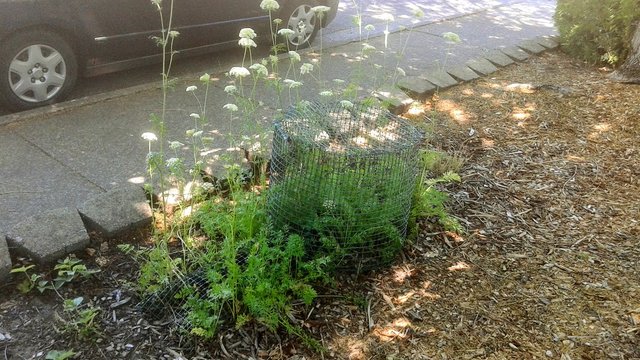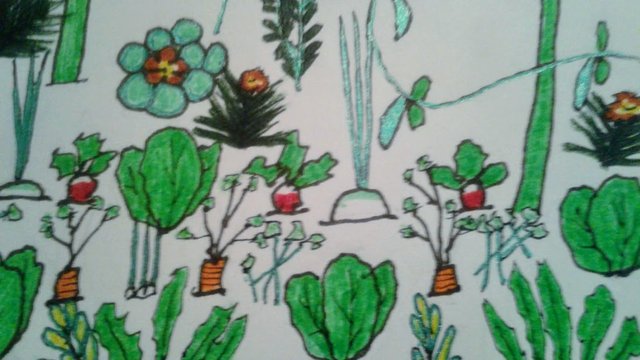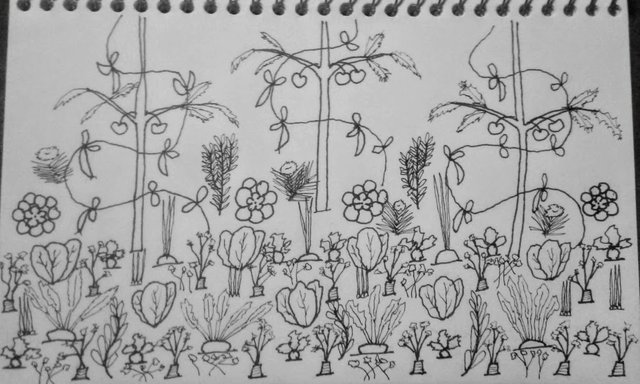Companion Plants Illustration: The Carrot Bundle [Gardening]
Introducing the third article in this series all about strategies to use for companion plants. In the first article I introduced my purpose, and how to choose plants that will help Peas to grow super productively. Last time I wrote about how to select plants to grow alongside Brassicas, like Brussels Sprouts and Cabbage, and what sort of site and climate they can tolerate.
In this third article, I continue the theme of companion planting bundles by sharing my illustration of plants that grow well with carrots.
The Carrot Bundle
Eh? What's up Doc?
Bugs Bunny, used this tagline many times on his wabbit-hunting rival Elmer Fudd.
While carrots are relatively easy to grow, I've wasted plenty of seeds to pesty critters who will happily gobble up the tender greens before the vegetable has a chance to take root. Carrots are extremely cold hardy, but only once the root set in. In fact, I planted seeds directly into the soil after the New Years, and found them sprouting two weeks later. Young carrot seedling cannot handle a strong freeze, and so my winter crop failed. Lesson learned!
With a little bit more tender loving care, better timing, and some helpful companions, carrots are one of the blessed vegetables that can be enjoyed all year long, ready to be harvested at any time.
Super Companion
This sole plant is sure to get a boost by being planted within the Carrot Bundle.
- Radish
Additional Companions
These ones should grow fine, but aren't super-boosted by any of the others nearby.
- Marigold
- Nasturtium
- Parsley
- Rosemary
- Sage
- Tomato
Sacrificial Plants
These ones will help give the carrots a boost, but might do poorly because of energy sapping rival plants in the Carrots Bundle. Include these plants for a better carrot harvest, but do not expect these plants to provide an exceptional harvest.
- Chives (dislikes Peas)
- Lettuce (dislikes Parsley)
- Onion (dislikes Peas)
- Peas (dislikes Onion)
Optional Addition
This plant does not boost the carrots, but it does not detract from carrots either. These can be added to the Carrots Bundle optionally to add to the variety of available plants to be harvested within the site location.
- Turnip
Pay special attention to the sacrificial plants. To keep these healthy enough to help support the carrots, I think it is wise to place these on opposite sides of the carrots, so that they do not have to sit directly adjacent to their rival plants.
Onions and Chives release a sulfur into the soil that Peas detest, so it might be good to place the onions near the front so they are within easy reach to harvest, and peas in the back. A row of tomatoes in the back will provide a natural trellis for the peas to climb over and weave through.
Lettuce does not let-us (pun!) plant it near parsley, so it could be grown under the shade of the peas, while the Parsley will enjoy growing in-between the onions.
Carrots may be grown in rows or randomly throughout the entire mix. Personally, I prefer to plant carrots in rows, with each row being a different variety of carrot. There are so many delicious colors, shapes, sizes, and flavors of carrots. It is fun to plant a variety of them, and try something new. All of the other plants can be staggered between the carrots evenly to help ward off pests and attract beneficial birds and insects.
Site Location
Wall Garden: Along a cement brick wall in our front yard, I have a site where I have been growing carrots for the past two years. I add lots of sand and compost to improve the natural clay soil every year. Whenever it rains, the sand shreds through the deeply packed clay. My hope is the sand settling through the soil allows water to drain better, and the carrots can drill through deeper each year. I allow many of the old carrots from past seasons to decompose in the soil to further improve the deep soil quality, which attracts worms. This supports my no-dig gardening strategy.

This plot of my garden receives full sun in the Spring, but only receives morning and evening sunlight in the Summer, because the trees above grow leaves that completely shade the area. For this reason, I learned that this area is not suitable for growing hot weather crops. The elaborately constructed cages were successful in protecting my pumpkins from predators, but the tall trees prevented the pumpkins from receiving enough sunlight. That is why I decided to change this site into a Carrot-Focused area, and grow the pumpkins somewhere else this year.
Many of the seeds in my Carrot Bundle list are slightly cold hardy, but they will require lots of added protection from the elements if they hope to survive the lingering cold effects of the current seasons.
My plan is to direct sow carrots, radish, and turnips. I know that the birds like to gobble up these seeds right after I plant them. Last year I pre-soaked them and coated them in cinnamon and chili powder, and that seemed to help my germination rate. The year before that I sprouted them in a plastic bag with cornstarch and water, and squirted the jelly of carrot sprouts into the soil, and that helps them grow quicker after sowing.
This year I purchased a few clear plastic bins which I will use as domes to protect the seeds. It think this will block the birds, add some humidity and moisture to the tender leaves, insulate some extra heat inside, and prevent the wind from chilling the soil at night. I also have some plastic bags that I can use as sheets to cover the entire row, alternatively to provide the same effect.
Lettuce and Peas will be grown indoors until they are mature enough to be transplanted outside. These plants do not require a lot of hardening off time, and can probably be transplanted directly when they look strong enough, as long as they are kept out of hot sun. I'll have to keep an eye out for slugs which will attack anything tender green during the cold rain season.
Tomatoes are being grown indoors. They will need a week or so to harden off. Tomatoes cannot tolerate any frost, so I will be waiting until after Mother's Day in May before I consider transplanting them into the garden plot.
Parsley grows easily for me when I direct sow. Rosemary will be added easily from cuttings from an existing plant. Sage will be transplanted in and divided from existing plants.
I am not sure about the onion and chives, whether I should sow them directly, or start them indoors. I am also going to attempt to grow Nasturtiums and Marigold from seed for the first time, and I am not sure if I should start these indoors or sow direct outside. Let me know if anyone has suggestions. I am running out of space indoors to grow seedlings.
Illustration
This image was drawn in pencil, and later inked in pen.
Markers were used to color in the image. Metallic green ink gel pens also added for special effect.
Anybody else enjoy coloring? Feel free to click the image for a full-scale view. I bet this would look even better with colored pencils.
Be sure to check out all of the articles in this companion planting series:
- 1: Companion Plants Illustration: The Peas Bundle
- 2: Companions Plants Illustration: The Brassicals Bundle
Coming Soon!
I've got more Companion Planting illustrations I'll be sharing through the week. They turned out really good, so I hope you stay tuned and check them out.
- Tomato Bundle
- Corn/Beans/Lettuce Bundles
- Apple/Fruit Trees Bundle
Thank you for checking out my hand drawn art illustrations. May it inspire you to grow and thrive in all that you aspire to do.
#carrot #carrot-bundle #onion #onions #chive #chives #green-onion #green-onions #spring-onions #sage #rosemary #turnip #turnips #radish #radishes #pea #peas #tomato #tomatoes #parsley #lettuce #nasturtium #marigold #marigolds #herb #herbs #propagation #companion-planting #vegetable-garden #art #markers #ink #ink-pen #ink-illustration


.jpg)

Dear Artzonian, thanks for using the #ArtzOne hashtag. Your work is valuable to the @ArtzOne community. Quote of the week: Art, freedom and creativity will change society faster than politics. -Victor Pinchuk
Hi creativetruth,
Visit curiesteem.com or join the Curie Discord community to learn more.
I don't grow vegetables, but if I ever do I am coming back to learn. I found it fascinating that you have sacrificial plants and certain plants don't like other plants. Who would of thought Peas don't like Onions. It is good to know and I am sure loads are ignorant to this fact.
Yes, that was a first year gardening mistake I made. Peas usually come up fast and perky, but near the chives and onions they come out slow and sickly.
It is good to know and I am sure experience is way better than reading up about it. I have never heard this and will definitely do a veggie patch one day and use you as a guide.
Very interesting post. Quite a lot to remember.
I must make a chart.
Farming can get so complicated. So many factors we have to consider.
This is a very helpful series. I mostly grow fruit trees. I give them away when they are big enough to be transplanted because I don't have where to plant them.
I'll pay more attention now to what plants near them hinder or favor their development.